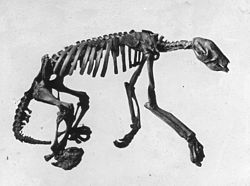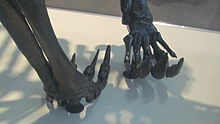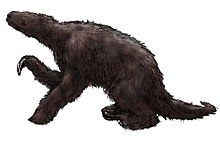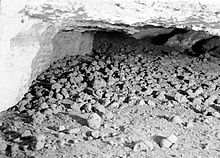- Nothrotheriops
-
Nothrotheriops 
Shasta ground sloth (Nothrotheriops shastense), nearly full grown, partly mummified body from bat guano in cave Conservation status FossilScientific classification Kingdom: Animalia Phylum: Chordata Class: Mammalia Order: Xenarthra Family: †Megatheriidae Subfamily: †Nothrotheriinae Genus: †Nothrotheriops
Hoffstetter, 1954Species - †N. shastensis (Sinclair 1905)
- †N. texanus (Hay 1916)
Nothrotheriops is a genus of Pleistocene ground sloth found in North and South America. This genus of bear-sized xenarthran was related to the much larger, and far more famous Megatherium, although it has recently been placed in a different family, Nothrotheriidae.[1]
Contents
Discovery and species
Fossils of the best-known species, the Shasta ground sloth (N. shastensis), have been found throughout western North America, especially in the American Southwest. The most famous specimen was recovered from a lava tube at Aden Crater in New Mexico and was found to still have hair and tendon preserved.[2] This nearly complete specimen is on display at the Yale Peabody Museum of Natural History in New Haven, Connecticut. Numerous dung boluses belonging to Nothrotheriops have also been found throughout the southwestern United States and have provided an insight into the diet of these extinct animals.
Although N. shastensis was one of the smallest ground sloth species, it still reached 2.75 meters from head to tail and weighed 250 kg (one-quarter of a tonne) - much smaller than some of its contemporary species such as the Eremotherium, which could easily weigh over two tons and be 6 meters long.[3] It had large, stout hindlegs and a powerful, muscular tail that it used to form a supporting tripod whenever it shifted from a quadrupedal stance to a bipedal one (i.e. Eremotherium).[4]
Ecology
Nothrotheriops shastensis behaved like all typical ground sloths of North and South Americas, feeding on various plants like the Desert Globemallow, cacti, and yucca. It was hunted by various local predators, like the Smilodon, from which the sloths may have defended themselves by standing upright on hindlegs and tail and swiping with their long foreclaws, like its distant relative Megatherium, as conjectured in the BBC series Walking with Beasts. The same claws could also been used as tools to reach past the plant spines and grab softer flowers and fruits. Also, the Shasta ground sloth may have had a prehensile tongue (like a giraffe) to strip leaves off branches.[4]
This species' ancestry dates back to the Miocene. Shasta ground sloths migrated to North America from South America during the Irvingtonian about 1 MYA. This species' range came as far north as the Canadian province of Alberta, making it one of the most northerly species of its clan, which otherwise lived primarity in the southern region of the North American continent, i.e. the states Texas, South Carolina and Florida.[3]
The best known historical specimen was found in a lava tube at Aden Crater in New Mexico; it was found with hair and tendon still preserved.[2] Also, prolonged period of search at Rampart Cave have revealed a plentiful amount of the sloth's hair and dung, which allowed the scientists both to use radiocarbon dating techniques to establish when it lived.[4]
References
- ^ Muizon, C. de; McDonald, H. G.; Salas, R.; Urbina, M. (June 2004). "The Youngest Species of the Aquatic Sloth Thalassocnus and a Reassessment of the Relationships of the Nothrothere Sloths (Mammalia: Xenarthra)". Journal of Vertebrate Paleontology (Society of Vertebrate Paleontology) 24 (2): 387–397. doi:10.1671/2429a. http://www.bioone.org/doi/abs/10.1671/2429a. Retrieved 2009-01-29.
- ^ a b Lull, S. 1929. A remarkable ground sloth. Memoirs of the Peabody Museum of Yale University, 3: 1-39.
- ^ a b Lange, Ian M., Ice Age Mammals of North America: A Guide to the Big, the Hairy, and the Bizarre, Mountain Press Publishing Company, 2002. Pg. 83, 85
- ^ a b c Barton Miles & Co., Prehistoric America. A journey through the Ice Age and beyond. BBC publishing, 2002. Pg 108-9.
Further reading
- Gill, Fiona L.; Crump, Matthew P.; Schouten, Remmert; Bull, Ian D. (2009). "Lipid analysis of a ground sloth coprolite". Quaternary Research (Elsevier) (72): 284–288. doi:10.1016/j.yqres.2009.06.006. http://www.chm.bris.ac.uk/~chidb/personal/content/paper33.pdf.
- Hofreiter, M; Poinar, HN; Spaulding, WG; Bauer, K; Martin, PS; Possnert, G; Pääbo, S (2000). "A molecular analysis of ground sloth diet through the last glaciation". Molecular Ecology (Blackwell Science) (9): 1975–1984. doi:10.1046/j.1365-294X.2000.01106.x. PMID 11123610. http://www.eva.mpg.de/genetics/pdf/HofreitMolMolecularEc200.pdf.
- Naples, Viriginia L. (1987), Reconstruction of Cranial Morphology and Analysis of Function in the Pleistocene Ground Sloth Nothrotheriops shastense (Mammalia, Megatheriidae), Contributions in Science 389, October 1987, Natural History Museum of Los Angeles County
- Schmidt, Gerald D.; Duszynski, Donald W.; Martin, Paul S. (1992), Parasites of the Extinct Shasta Ground Sloth, Nothrotheriops shastensis, in Rampart Cave, Arizona, J. Parasitol., 78(5), 1992, p. 811-816, American Society of Parasitologists
- Steadman et al. (2005). Asynchronous extinction of late Quaternary sloths on continents and islands, PNAS, doi:10.1073/pnas.0502777102
External links
Categories:- Prehistoric sloths
- Pleistocene mammals
- Pleistocene extinctions
- Megafauna of North America
Wikimedia Foundation. 2010.



